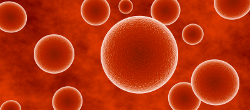Finding Specimens for the Foldscope
Required: Red Onion
The only specimen you need for this lab is red onion (Allium cepa). Red onions contain anthocyanin pigments that make the cells easy to see - no staining required! Simply pull or scrape a tiny piece of the red membrane from any inner layer of the onion (not the dry, papery outer layer), and place it on your slide for viewing (see Slide Preparation and Photo Tips).
You may have a red onion at your home, or you can buy one at the grocery store if you want. Even a small piece of red onion that you may find in your salad* will have more than enough material for you to make your slide (as long as there is a red layer present).
Required Specimen: Red Onion
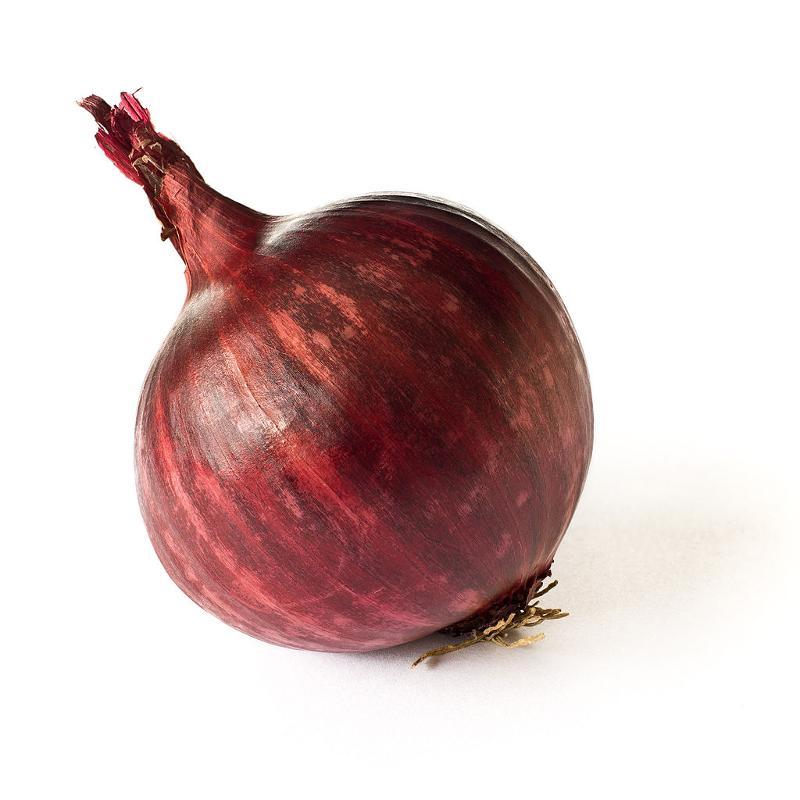
Whole red onion.
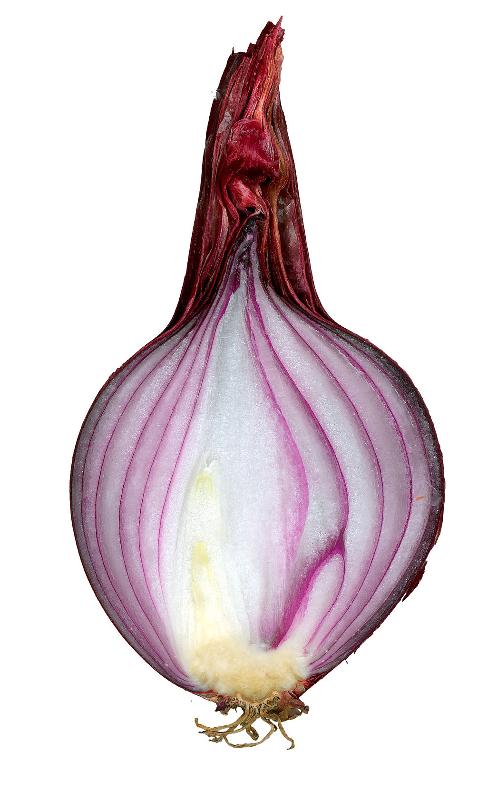
Cut red onion, showing pigmented layers between the scales.
Optional: Other Organisms
You're free to explore as much as you like with your foldscope; some suggestions follow below. You will need to make more foldscope slides for another lab in this course, however, so keep that in mind and don't use up all of your slides. (You can make your own slides with heavier weight paper -- like greeting card paper -- and transparent tape if you need to.) If you decide to try other specimens, please heed the Notes of Caution section, below.
Additional Equipment
We provide you with a foldscope, transfer pipette, and a pair of gloves. You may also want to gather together the following items:
- small container with a lid - pop bottle, etc., for wet specimens (spice jars from the dollar store work well)
- small plastic bag or envelope for dry specimens such as leaves, pollen, spores, etc. (but prepare them for viewing as soon as possible after collecting)
- toothpicks, plastic utensils, or other similar items (something you can scrape with) for taking small soil samples or collecting samples from the surface of rocks or trees
- a longer, thin stick such as a pencil, chopstick, barbeque skewer, etc. to safely extend your reach if necessary
- paper or a notebook and pencil
- camera
- tweezers (if you have them)
- a grocery bag or other container for collecting garbage
Algae and Plants
Filamentous green algae are good foldscope candidates because they are just a few cell layers thick (often only one or two). At your collecting site (see Collecting Tips: Locations, below), look for rocks or muddy patches with a greenish cast or film on the surface. In lakes, you may also see obvious clumps of filamentous algae that are either clinging to rocks or floating freely in the water (but see Notes of Caution, below). On shore, look for a green film on the surface of rocks. If you or someone you know has a fish tank, you might find some algae there.
Plant leaves may also work, but they must be very thin - if a specimen is more than a few cell layers thick, then it will be too thick for the cells to be visible. Choose leaves from plants that that are naturally very small (rather than using fragments of larger leaves), and look near the exterior margins of the leaf or near the veins, where the leaf tissue is typically thinner. Mosses and other ground-hugging weedy plants are good candidates, as are fish tank ornamentals such as Elodea.
If you collect a small amount of mud from a damp or marshy area, you have a good chance of finding motile organisms, even if you don't find algae. You may even want to try collecting a spoonful of soil in a glass jar, adding some water, and leaving it to sit in a sunny location. After a few days, you may have some algae growing in the jar! (If you try this, choose soil from a damp or shaded area with lots of plants growing).
organisms, even if you don't find algae. You may even want to try collecting a spoonful of soil in a glass jar, adding some water, and leaving it to sit in a sunny location. After a few days, you may have some algae growing in the jar! (If you try this, choose soil from a damp or shaded area with lots of plants growing).
Other Specimens to Try (Optional)
- mushroom gills: whole mushrooms from a grocery store or the dining hall only - do no collect wild mushrooms!
- flower parts (petals, stamens, anthers): as with leaves, the smaller and thinner the better. There are lots of teeny tiny flowers out there if you look carefully!
- pollen grains: tap a flower head onto your foldscope slide
- fern sporangia (in season): look for the bumps on the underside of larger fern leaves; each bump is a sorus
 (pl. sori) that consists of many sporangia - gently scrape a sorus into your collecting envelope / bag
(pl. sori) that consists of many sporangia - gently scrape a sorus into your collecting envelope / bag - lichen - macerate
 a small amount with a spoon or other blunt object in a small amount of water to increase your chances of seeing something recognizable
a small amount with a spoon or other blunt object in a small amount of water to increase your chances of seeing something recognizable
Notes of Caution
While collecting specimens for the foldscope is a low-risk activity, you are responsible for using common sense and due caution. You should be able to collect and prepare interesting specimens without entering bodies of water or using
potentially dangerous tools such as blades or scissors. Collect only in a location and manner that you judge to be safe, and do not risk injury or misadventure.
Please DO:
- wash your hands as soon as possible after your collecting trip
- wash any extra non-disposable equipment that you may have used
- dispose of any disposable equipment you may have used in the appropriate manner (compost, recycling, landfill, etc.)
- pick up some garbage while you're out exploring and dispose of it properly (that's mainly what the gloves are for...)
- tell someone where you're going - or, better yet - bring a friend!
Please DO NOT:
- enter the ocean or lakes, or anywhere where there is moving water (flowing streams, etc.)
- trespass on private property
- collect specimens where you feel unsafe or where it is unsafe to walk
- walk on submerged rocks, or on rocks covered in algae (whether submerged or not)
- use blades or other sharp objects to prepare your specimens
- handle wild mushrooms (see 'Other Specimens to Try', above)
- ingest anything you collect
- use any non-disposable collecting equipment for food preparation or storage
Collecting Tips: Locations
On / Near Campus
- Ocean Pond - located between the Chase Building and the corridor between the LSC and Chemistry building. This is a small, marshy area that has been allowed to grow in naturally since it was established several years ago. Neither ocean nor pond, but you should at least find a puddle or two! If you don't find algae here, try collecting a small amount of mud and water.
- walkways - keep your eyes on the ground and look for algal growth on the compressed soil around the concrete / conglomerate pavers.
- South Street - follow South St. past Beaufort Avenue until it comes to an end at the Northwest Arm. There is a small rocky beach here where you may find some drift seaweed. If you see anything green and stringy, take a little bit! Do not enter the water.
- Dalhousie Outdoor Ecolab (outer edges only) - in the wooded area behind Sheriff Hall, home of the Bill Freedman Plant Collection. While Dr. Freedman would be thrilled to see students studying this area closely, as of Fall 2018 it is in the early stages of being established. Please enjoy this area from the perimeter only, and don't walk through it until there is interpretive signage.
Further Afield
- The Halifax Regional Municipality manages a number of parks with beach access to freshwater lakes. Please note that lifeguard supervision is provided only during the summer months (May-August). Do not enter the water or collect specimens at any beaches or lakes where a risk advisory is in effect.
- Point Pleasant Park - Check the beach for green filamentous material among the seaweed that has washed ashore, or look for puddles and ponds in the interior of the park.
- Belcher's Marsh Park and Little Belcher's Pond Park - both accessible from Parkland Drive in Clayton Park; Little Belcher's has easier access to the water.
At the Site
Take a few photos of the site in general and the specific spot where you collect your specimen, safely collect the specimen, and make notes about the time, location, and weather conditions (see the assignment document attached to the dropbox for this lab).
If collecting wet or muddy specimens, nearly fill your specimen bottle with water from the site; then add your specimen. Or, bring some tap water with you, for algae that you may collect from relatively dry spots as well, such as the surface of rocks or soil. For sites on Halifax Harbour or the Northwest Arm, collect a small amount of water at the site. (This will be seawater; any specimens you collect that came from seawater should be stored in seawater, not fresh or tap water).
Optional Specimens
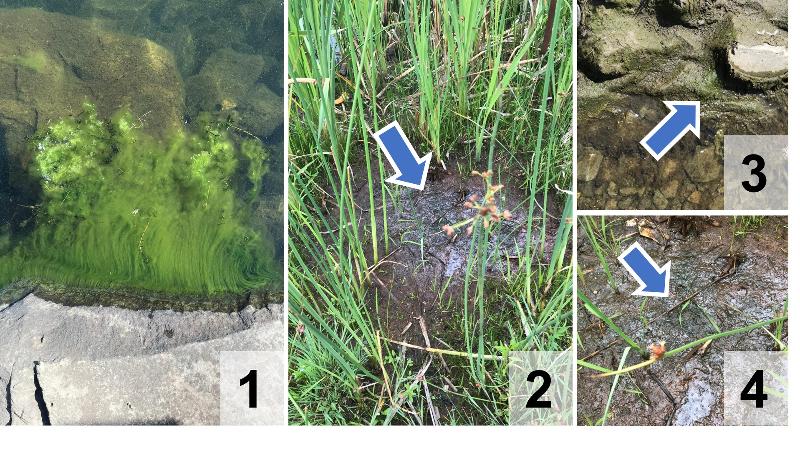
Filamentous algae in various locations: attached to rocks in Lake Banook (1 and 3); on the surface of the mud near the shore of Maynard Lake (2 and 4 - look closely for the greenish film on the mud)
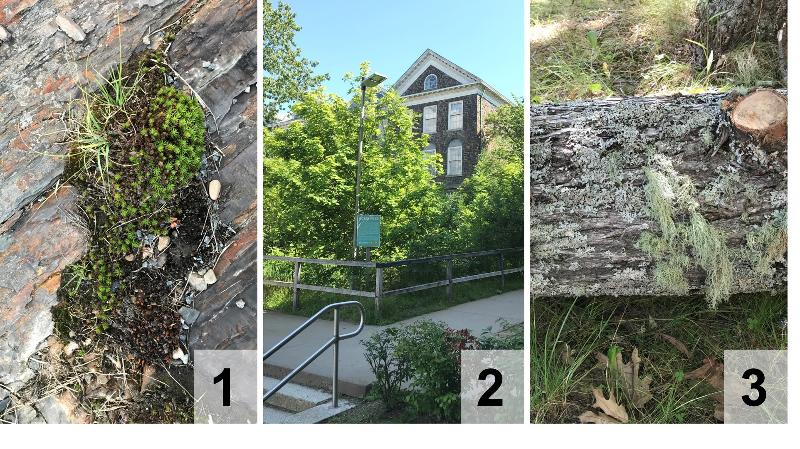
Locations around campus: (1) moss on a rock wall (2) Ocean Pond (3) lichen on a log behind Sheriff Hall (at the perimeter of the Dalhousie Outdoor Ecolab)
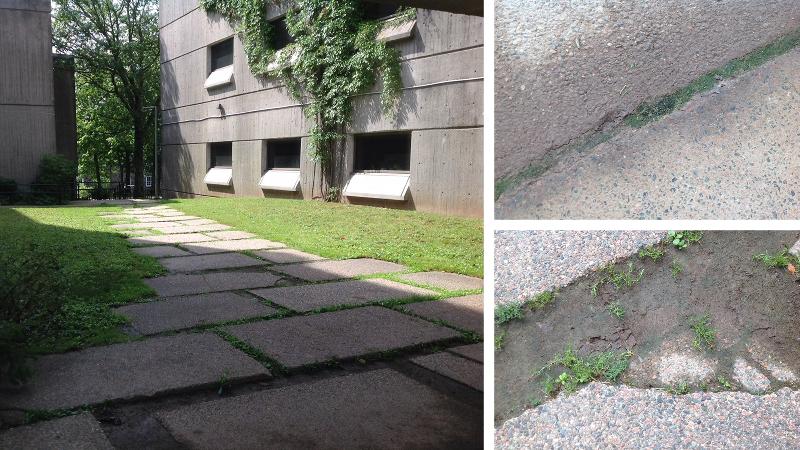
Locations around campus: the walkway behind the LSC, between the Psychology wing and Oceanoraphy (Sherriff Hall is in the distance, behind the trees; the Dalhousie Outdoor Ecolab is among the trees)
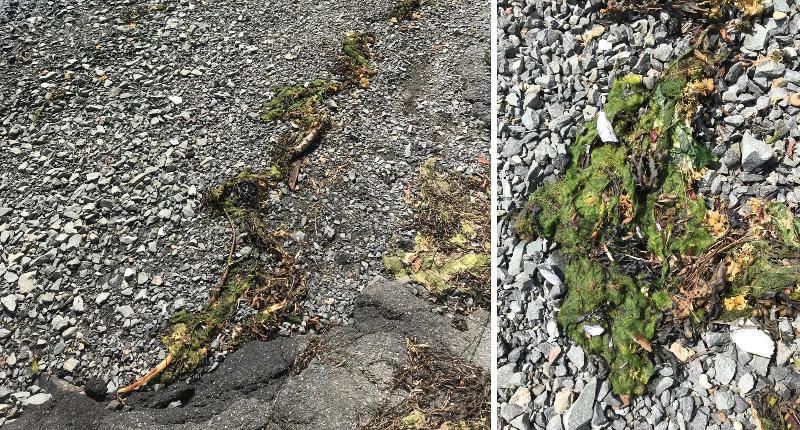
Drift algae on the beach at the end of South Street, on the Northwest Arm.

Grow your own algae in a jar - just add water!!
* or at the dining hall salad bar - just sayin'
Image Credits
"Red Onion on White" by © User:Colin [CC BY-SA 3.0] via Wikimedia Commonsred onion cut by Amada44 [Public domain], via Wikimedia Commons
All photos under 'Optional Specimens' by Jennifer Van Dommelen.
